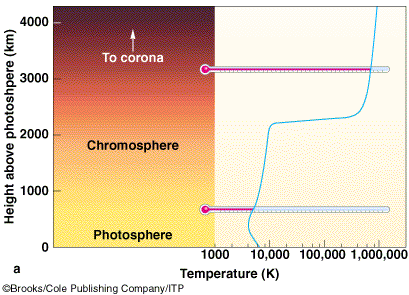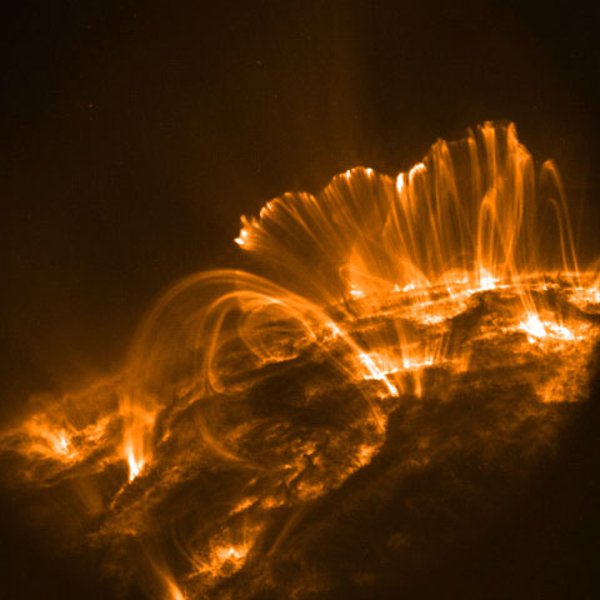|
Atoms are electrons and positrons, 2d and 3d photon quanta with opposite and like polarity to the fields of stars and planets, composed of charge and moments induced by core ions trapped by field lines transformed from electrons which transform electrons and positrons into atoms composing matter and antimatter universes where electrons in one polarity universe have the same polarity as positrons in the other.
Starlight ionizes atoms in deep space which frees electrons and solar winds attract electrons inducing a voltage potential between stars and deep space powering solar electric currents which transform the voltage potential into kinetic energy until electrical resistance of the corona transforms kinetic energy into photons, radiated outward as starlight and transformed into protons composing the solar wind.
The solar current electrifies the solar atmosphere which traps electrons on coronal loops, field lines grounded on the solar core and extended above the atmosphere by the repelling force between trapped electrons, and powers CMEs, of ionized coronal mass trapped in coronal loops by field lines grounded on the core, by explosively extending field lines antisunward when the CME escapes solar gravity.
When a CME intersects the planetary field electrified field lines drape and open circuits with planetary field lines, grounded in the atmosphere inside the auroral ovals, inducing a voltage potential powering high amperage sheet currents of CME electrons inducing auroras and electrifing sectors of the ovals facing the night sky during storms. SolarCycle 24: 2013 x 2014 x 2015 x 2016 x 2017 The repelling force between electrons powers expansion of the electrified air mass away from the poles, pushing back the ambient mid latitude air mass and increasing wind speed, barometric pressure and extreme weather along the interface including winter storms, flash flooding tornadoes and wildfires. The coreolis force powers anticlochwise rotation of storm cells of ionized droplets which transforms the momentum of rotating charges into dipole moments and sum of moments into a dipole field along the rotation axis, electrically attracting cloud droplets toward the ground and counterflowing currents of ground charge up field lines which transforms the momentum of spiralling charges into moments which increase the attractive force of the dipole field directly as the amperage of the current.
Electrified weather systems charge land surfaces and the oceans inducing a voltage potential between the surface and core where electrons transform into field lines and the voltage potential powers core electric currents, from land surfaces along ferrous conductors and from the deepwater oceans through the electrolyte discharge from hydrothermal vents in the deep ocean trenches. For photons with high photon energy (MeV scale and higher), pair production is the dominant mode of photon interaction with matter. These interactions were first observed in Patrick Blackett’s cloud chamber, leading to the 1948 Nobel Prize in Physics. If the photon is near an atomic nucleus, the energy of a photon can be converted into an electron–positron pair. The planetary field transforms photons induced by mantle heating into electron positron pairs at the olanetary core surface where electrons transform into field lines resulting in residual positrons which merge in trios, trios are trapped by transiting electrons and transform into protons which transform with electrons into mantle elements which increases planetary mass and surface area, as magma upwells and forms new lithosphere between the spreading oceanic plates.
Before the oceans Earth was in geosyncroneous orbit with Mars with similar mass, surface area, curvature, gravity, rotation period and axial tilt. The lithosphere draped the planet in an unbroken rocky shell, puntuated by volcanoes which relieved internal pressure and increased planetary surface area by thickening the lithosphere.
Since the beginning of the Mesozoic Era earth has increased in mass tenfold, surface gravity has increased 2.5 times, planetary surface area has increased, and surface curvature has decreased, from the surface area and surface curvature of mars to the surface area and surface curvature of earth, where oceans now cover 70% of the planetary surface. |
Atoms are electrons and positrons 2d & 3d photon quanta with opposite and like polarity to the fields of stars and planets






